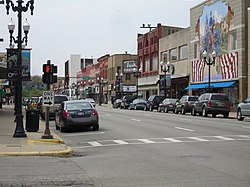
City Point is an area in what is now The Hill neighborhood of the city of New Haven, Connecticut, located in the southwestern portion of the city. The City Point area was, when settled and through the 18th century, a relatively narrow peninsula extending south into New Haven Harbor, located where the West River empties into the harbor. Areas adjacent to the original peninsula have since been filled in, broadening its shoulders, and Interstate 95 has cut across it. The Oyster Point Historic District is a 26-acre (11 ha) historic district encompassing an area of relatively old buildings in City Point south of I-95.

The Sycamore Historic District is a meandering area encompassing 99 acres (400,000 m2) of the land in and around the downtown of the DeKalb County, Illinois, county seat, Sycamore. The area includes historic buildings and a number of historical and Victorian homes. Some significant structures are among those located within the Historic District including the DeKalb County Courthouse and the Sycamore Public Library. The district has been listed on the National Register of Historic Places since May 2, 1978.
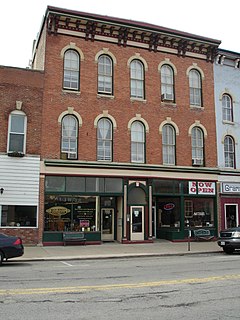
The Knuessl Building is a historic mid-19th Century commercial building in downtown Ottawa, Illinois. It was built around 1868 by a local pharmacist. The Knuessl Building was added to the U.S. National Register of Historic Places in 1992.

The Scales Mound Historic District is a historic district in the small Illinois village of Scales Mound. The district encompasses the entire corporate limit of the village and has more than 200 properties within its boundaries. The district was added to the U.S. National Register of Historic Places in 1990.

The Central Troy Historic District is an irregularly shaped, 96-acre (39 ha) area of downtown Troy, New York, United States. It has been described as "one of the most perfectly preserved 19th-century downtowns in the [country]" with nearly 700 properties in a variety of architectural styles from the early 19th to mid-20th centuries. These include most of Russell Sage College, one of two privately owned urban parks in New York, and two National Historic Landmarks. Visitors ranging from the Duke de la Rochefoucauld to Philip Johnson have praised aspects of it. Martin Scorsese used parts of downtown Troy as a stand-in for 19th-century Manhattan in The Age of Innocence.

There are nine historic districts in Meridian, Mississippi. Each of these districts is listed on the National Register of Historic Places. One district, Meridian Downtown Historic District, is a combination of two older districts, Meridian Urban Center Historic District and Union Station Historic District. Many architectural styles are present in the districts, most from the late 19th century and early 20th century, including Queen Anne, Colonial Revival, Italianate, Art Deco, Late Victorian, and Bungalow.

There are 68 properties listed on the National Register of Historic Places in Albany, New York, United States. Six are additionally designated as National Historic Landmarks (NHLs), the most of any city in the state after New York City. Another 14 are historic districts, for which 20 of the listings are also contributing properties. Two properties, both buildings, that had been listed in the past but have since been demolished have been delisted; one building that is also no longer extant remains listed.
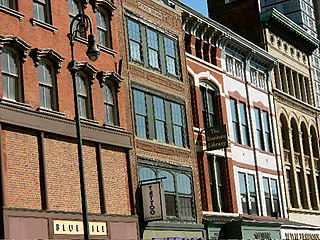
The Ninth Square Historic District encompasses a historically diverse and well-preserved part of the commercial area of Downtown New Haven, Connecticut. The district is bounded by Church, Court, State, and Crown Streets, and is centered on the intersection of Chapel and Orange Streets. The buildings in the district are mostly late-19th and early 20th commercial buildings, and includes a number of commercial buildings from the first half of the 19th century, a rarity in most of Connecticut's urban downtown areas. The district was listed on the National Register of Historic Places in 1984.

Ravenswood "Old Town" Historic District is a national historic district located at Ravenswood, Jackson County, West Virginia. It encompasses 313 contributing buildings and two contributing structures, the Ohio River Rail Road Steel Pratt-through truss Bridge and Concrete bridge on State Route 68 over Sandy Creek. It includes the commercial and civic core of the town, and surrounding residential buildings. It includes example of popular architectural styles of the mid- to late-19th and early-20th century, including Greek Revival, Gothic Revival, Queen Anne, Colonial Revival, Italianate, Craftsman, and Bungalow. Notable buildings include the McIntosh Building, First Baptist Church, Randolph Building/Caldwell Building (1907), the Grace Episcopal Church ; Our Savior Evangelical Lutheran Church, Ravenswood Community Center (1938), and McIntosh House.

The Middleburg Historic District comprises the historic center of Middleburg, Virginia. The district extends along the downtown section of Washington Street, and is flanked on the east by Independence Street and to the west by Constitution Street. The district's commercial area is along Washington and Madison Streets. Middleburg was established in 1787, but the historic district includes few 18th-century structures, with most dating to the mid-19th century. The district includes the Red Fox Inn & Tavern, the oldest building in town and listed individually on the National Register of Historic Places. Most of the structures in the core of the district are Federal style townhouses.

The Highland Park Historic Business District at Euclid and Sixth Avenues is located in the north-central section of Des Moines, Iowa, United States. It is located on the border of the Oak Park and Highland Park neighborhoods. The commercial historic district has been listed on the National Register of Historic Places since 1998. The Highland Park neighborhood also includes the College Corner Commercial Historic Business District.

The Centralia Commercial Historic District is a historic commercial district comprising several blocks of Broadway in downtown Centralia, Illinois. The district includes 57 contributing buildings as well as a historic water tower and sign. Centralia's business district developed around the Illinois Central Railroad tracks, as the town was established by and named for the railroad. The earliest buildings in the district date from the 1850s, as the city was platted in 1853. Centralia's first commercial buildings were mainly designed in the Italianate style, which was predominant until the end of the 19th century; the Romanesque Revival style also gained popularity in the 1880s. Around the turn of the century, the Commercial style became the most popular style in the district. The Renaissance Revival and Classical Revival styles can also be seen in buildings from this era, and by the 1930s Art Deco and Modernist architecture became popular.

The Morrison Main Street Historic District is a national historic district in Morrison, Illinois. The district encompasses an eight-block commercial area in downtown Morrison and includes 65 buildings, 53 of which are contributing buildings. Development in the district began in the 1850s, the same decade that Morrison was platted and incorporated, and continued through the mid-20th century. The district's growth was tied to the city's primarily agricultural economy and was spurred by its access to the Chicago and North Western Railway in the 19th century and the Lincoln Highway in the 20th. The most prevalent architectural styles in the district are Italianate and High Victorian Eclectic, both of which were most popular in the mid-to-late 19th century; other styles which can be found in the district include Romanesque Revival, Commercial, Classical Revival, Modernist, and various vernacular designs.
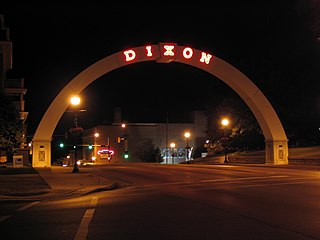
The Dixon Downtown Historic District is a historic district which encompasses 154 properties in downtown Dixon, Illinois. The district includes the city's commercial core, which includes buildings dating back to the 1850s. Dixon's commercial buildings are largely two-story brick structures and reflect the popular architectural styles of their era of construction; the Italianate style is most common in 19th-century buildings, while the Commercial style and revival styles such as Neoclassical and Beaux-Arts became popular after 1900. Many of Dixon's prominent government and community buildings also lie within the district, including the Lee County Courthouse, City Hall, its current and former post offices, and several churches. A residential section on the west side of the district includes Queen Anne and Craftsman style homes; the former style was popular in the late 19th century, while the latter was popular in the early 20th.

The Ottawa East Side Historic District is a residential historic district in eastern Ottawa, Illinois. The district is located on a peninsula formed by the confluence of the Fox River and Illinois River and is only connected to the rest of Ottawa by a single bridge. The area's relative isolation caused the city's businesses and industries to avoid building there, and as a result the district became almost entirely residential. Construction in the East Side began in 1848, when developer Henry Green built his home there, and continued rapidly through the 19th century; after a brief slowdown at the turn of the century, development continued in the 1910s and 1920s before stopping almost entirely during the Great Depression. The neighborhood was one of the most desirable in the city, and Ottawa's upper class built many large homes there; however, it also includes several smaller middle-class houses. The Greek Revival, Italianate, and Queen Anne styles are all well-represented in the district's larger and more formal homes, while many vernacular styles can be seen in the smaller homes.

The Elgin Downtown Commercial District is a historic district encompassing the commercial core of downtown Elgin, Illinois. The district includes 94 buildings, 76 of which are considered contributing buildings to its historic character. While development in downtown Elgin began in the 1830s, the oldest buildings in the district were built in the 1870s; most of the district's buildings were built in the late 19th and early 20th centuries, but its development continued through the 20th century. The majority of the buildings in the district are two- and three-story commercial buildings, but it also includes several taller commercial buildings, churches, a public library, and a power station. Most of the 19th-century buildings in the district have Italianate or Queen Anne designs, while the 20th-century buildings features styles such as Colonial Revival and Renaissance Revival.

The Walnut Street Historic District is a nationally recognized historic district located in Waterloo, Iowa, United States. It was listed on the National Register of Historic Places (NRHP) in 2019. At the time of its nomination the district consisted of 111 resources, including 91 contributing buildings and 20 non-contributing buildings. The district is largely a residential area located between the central business district and the former location of the Illinois Central Railroad round house and shops. The neighborhood was originally platted as the Railroad Addition in 1860 and as the Cooley Addition in 1865. Buildings date from c. 1880 to 1981. Single-family houses are largely wood-frame construction with a few brick. Architectural styles include Queen Anne, Italianate, Shingle, Bungalow, variations on the American Foursquare, and those in a vernacular mode. Multi-family dwellings include double houses, identical houses, and apartment buildings. There are also a few commercial buildings on East Fourth Street and two churches. Walnut Street Baptist Church (1908) is individually listed on the NRHP. Two local architects, Mortimer Cleveland and Clinton Shockley have buildings in the district.
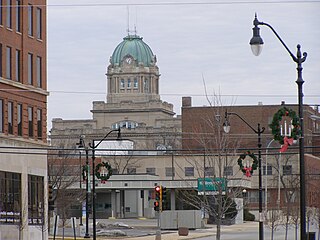
The Kankakee Downtown Historic District is a national historic district in downtown Kankakee, Illinois. The district includes 73 buildings which form the commercial and governmental center of the city, most of which are grouped along Court Street and Schuyler Avenue. While development in the district began in the 1850s, the oldest surviving building in the district is from 1864; the newest contributing buildings are from the mid-twentieth century. Kankakee's Courthouse Square and the 1908 Kankakee County Courthouse are part of the district; other government buildings in the district include Kankakee's post office, police and fire station, and armory. Most of the district's other buildings are one- to three-story brick or stone commercial buildings. Many popular architectural styles of the nineteenth and twentieth centuries are represented in the district; the Italianate, Neoclassical, and Art Deco styles are among the most common.

The LaSalle Downtown Commercial District is a national historic district in downtown LaSalle, Illinois. The district encompasses 93 contributing buildings which historically formed the commercial and governmental center of LaSalle. Development in downtown LaSalle began with the completion of the Illinois and Michigan Canal in 1837 and the construction of railroads through the city in the 1850s; it continued through the mid-twentieth century. The district's commercial buildings represent many architectural styles, with popular styles of the late nineteenth century such as Italianate, Queen Anne, and Romanesque Revival being the most common. Significant government buildings include the LaSalle City Building and two post office buildings.

The Downtown Rock Island Historic District is a national historic district encompassing 82.3 acres (33.3 ha) in downtown Rock Island, Illinois. The oldest buildings in the district are from the 1860s, two decades after Rock Island's founding, and buildings from then until 1969 can be found in the district, making it reflective of the city's development over time. The majority of the buildings in the district are commercial buildings, as downtown Rock Island has historically been the city's commercial center; these include several building types, mainly one-part and two-part commercial blocks, designed in a wide variety of the architectural styles popular in the late nineteenth and early to mid twentieth centuries. The district was also historically the center of Rock Island's social life, and many theaters and clubhouses for social organizations can be found in the district. Several of Rock Island's major government buildings, including the city hall and old county courthouse, are also part of the district.
